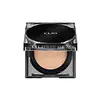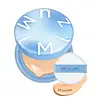What's inside
What's inside
 Key Ingredients
Key Ingredients

 Benefits
Benefits

 Concerns
Concerns

 Ingredients Side-by-side
Ingredients Side-by-side

Water
Skin ConditioningCyclopentasiloxane
EmollientCI 77891
Cosmetic ColorantEthylhexyl Methoxycinnamate
UV AbsorberButylene Glycol
HumectantEthylhexyl Salicylate
UV AbsorberLauryl PEG-9 Polydimethylsiloxyethyl Dimethicone
Skin ConditioningCetyl Ethylhexanoate
EmollientNiacinamide
SmoothingPolymethylsilsesquioxane
1,2-Hexanediol
Skin ConditioningCI 77492
Cosmetic ColorantMethyl Trimethicone
Skin ConditioningPEG-10 Dimethicone
Skin ConditioningSilica
AbrasiveIsododecane
EmollientAcrylates/Dimethicone Copolymer
Skin ConditioningMagnesium Sulfate
Alumina
AbrasiveTriethoxycaprylylsilane
Aluminum Hydroxide
EmollientOctyldodecanol
EmollientPEG-9 Polydimethylsiloxyethyl Dimethicone
EmulsifyingAdenosine
Skin ConditioningTrisodium Ethylenediamine Disuccinate
Dimethicone
EmollientPolypropylsilsesquioxane
Polyglyceryl-4 Isostearate
EmulsifyingIsopropyl Titanium Triisostearate
EmollientHydroxypropyltrimonium Hyaluronate
Tocopherol
AntioxidantParfum
MaskingBenzyl Benzoate
AntimicrobialLinalool
PerfumingLimonene
PerfumingMica
Cosmetic ColorantCI 77491
Cosmetic ColorantCI 77499
Cosmetic ColorantDisteardimonium Hectorite
StabilisingCetearyl Dimethicone/Vinyl Dimethicone Crosspolymer
EmollientCetearyl Dimethicone
EmollientStearic Acid
CleansingWater, Cyclopentasiloxane, CI 77891, Ethylhexyl Methoxycinnamate, Butylene Glycol, Ethylhexyl Salicylate, Lauryl PEG-9 Polydimethylsiloxyethyl Dimethicone, Cetyl Ethylhexanoate, Niacinamide, Polymethylsilsesquioxane, 1,2-Hexanediol, CI 77492, Methyl Trimethicone, PEG-10 Dimethicone, Silica, Isododecane, Acrylates/Dimethicone Copolymer, Magnesium Sulfate, Alumina, Triethoxycaprylylsilane, Aluminum Hydroxide, Octyldodecanol, PEG-9 Polydimethylsiloxyethyl Dimethicone, Adenosine, Trisodium Ethylenediamine Disuccinate, Dimethicone, Polypropylsilsesquioxane, Polyglyceryl-4 Isostearate, Isopropyl Titanium Triisostearate, Hydroxypropyltrimonium Hyaluronate, Tocopherol, Parfum, Benzyl Benzoate, Linalool, Limonene, Mica, CI 77491, CI 77499, Disteardimonium Hectorite, Cetearyl Dimethicone/Vinyl Dimethicone Crosspolymer, Cetearyl Dimethicone, Stearic Acid
Water
Skin ConditioningCyclopentasiloxane
EmollientEthylhexyl Methoxycinnamate
UV AbsorberTrimethylsiloxysilicate
EmollientGlycerin
HumectantIsododecane
EmollientCetyl PEG/PPG-10/1 Dimethicone
EmulsifyingSilica
AbrasiveNylon-12
Dimethicone/Vinyl Dimethicone Crosspolymer
Skin ConditioningDisteardimonium Hectorite
StabilisingMagnesium Sulfate
Phenyl Trimethicone
Skin ConditioningPhenoxyethanol
PreservativeIsononyl Isononanoate
EmollientBis-Diglyceryl Polyacyladipate-2
EmollientAluminum Hydroxide
EmollientTriethoxycaprylylsilane
Chlorphenesin
AntimicrobialButylene Glycol
Humectant1,2-Hexanediol
Skin ConditioningSodium Hyaluronate
HumectantHydrolyzed Hyaluronic Acid
HumectantSodium Acetylated Hyaluronate
HumectantThymus Serpyllum Extract
Skin ConditioningMaltodextrin
AbsorbentEchinacea Purpurea Extract
MoisturisingRhodiola Rosea Extract
EmollientWater, Cyclopentasiloxane, Ethylhexyl Methoxycinnamate, Trimethylsiloxysilicate, Glycerin, Isododecane, Cetyl PEG/PPG-10/1 Dimethicone, Silica, Nylon-12, Dimethicone/Vinyl Dimethicone Crosspolymer, Disteardimonium Hectorite, Magnesium Sulfate, Phenyl Trimethicone, Phenoxyethanol, Isononyl Isononanoate, Bis-Diglyceryl Polyacyladipate-2, Aluminum Hydroxide, Triethoxycaprylylsilane, Chlorphenesin, Butylene Glycol, 1,2-Hexanediol, Sodium Hyaluronate, Hydrolyzed Hyaluronic Acid, Sodium Acetylated Hyaluronate, Thymus Serpyllum Extract, Maltodextrin, Echinacea Purpurea Extract, Rhodiola Rosea Extract
 Reviews
Reviews

Ingredients Explained
These ingredients are found in both products.
Ingredients higher up in an ingredient list are typically present in a larger amount.
1,2-Hexanediol is a synthetic liquid and another multi-functional powerhouse.
It is a:
- Humectant, drawing moisture into the skin
- Emollient, helping to soften skin
- Solvent, dispersing and stabilizing formulas
- Preservative booster, enhancing the antimicrobial activity of other preservatives
Aluminum Hydroxide is a form of aluminum. It can be naturally found in nature as the mineral gibbsite. In cosmetics, Aluminum Hydroxide is used as a colorant, pH adjuster, and absorbent.
As a colorant, Aluminum Hydroxide may add opacity, or reduce the transparency. Aluminum hydroxide is contains both basic and acidic properties.
According to manufacturers, this ingredient is an emollient and humectant. This means it helps hydrate the skin.
In medicine, this ingredient is used to help relieve heartburn and help heal ulcers.
There is currently no credible scientific evidence linking aluminum hydroxide in cosmetics to increased cancer risk.
Major health organizations allow the use of aluminum hydroxide in personal care products and have not flagged it as a carcinogenic risk at typical usage levels.
Learn more about Aluminum HydroxideButylene Glycol (or BG) is used within cosmetic products for a few different reasons:
Overall, Butylene Glycol is a safe and well-rounded ingredient that works well with other ingredients.
Though this ingredient works well with most skin types, some people with sensitive skin may experience a reaction such as allergic rashes, closed comedones, or itchiness.
Learn more about Butylene GlycolCyclopentasiloxane, or D5, is a silicone used to improve texture of products and trap moisture.
D5 is considered lightweight and volatile. Volatile means it evaporates quickly after application. Once evaporated, D5 leaves a thin barrier that helps keep skin hydrated.
It is also an emollient. Emollients help soften the skin and prevent water loss. Silicones create a silky texture in products. D5 helps other ingredients become more spreadable.
Studies show D5 is safe to use in skincare products. We recommend speaking with a skincare professional if you have concerns.
Learn more about CyclopentasiloxaneDisteardimonium Hectorite comes from the clay mineral named hectorite. It is used to add thickness to a product.
It can also help stabilize a product by helping to disperse other ingredients.
Hectorite is a rare, white clay mineral.
Learn more about Disteardimonium HectoriteEthylhexyl Methoxycinnamate is an organic compound that provides UVB protection. It often goes by the more common name of octinoxate. It is created from methoxycinnamic acid and 2-ethylhexanol.
Ethylhexyl Methoxycinnamate absorbs UVB rays with wavelengths between 280-320 nm. UV absorbers protect your skin by using chemical reactions to convert UV rays into heat and energy.
UVB (290-320 nm) rays emit more energy than UVA rays. They are capable of damaging DNA, causing sunburns and are thought to be linked to skin cancer.
The state of Hawaii has banned sunscreens containing octinoxate due to its potential impact on coral reefs. More research is needed to bridge gaps in this research. The European Union allows higher levels of octinoxate in sunscreens than the US and Australia.
Ethylhexyl Methoxycinnamate is oil soluble. It is not stable and may lose efficacy when exposed to sunlight.
Learn more about Ethylhexyl MethoxycinnamateIsododecane is a fragrance, emollient, and solvent.
As an emollient, it helps your skin stay soft and hydrated. Emollients help trap moisture into your skin.
Isododecane's role as a solvent makes it a great texture enhancer. It spreads smoothly on skin and does not leave a sticky feeling behind. Isododecane also helps prevent color transfer in makeup products.
Isododecane is not absorbed into skin.
Learn more about IsododecaneMagnesium Sulfate is a salt. More specifically, it is an epsom salt, or the bath salt used to help relieve muscle aches.
Despite having ‘sulfate’ in the name, it isn’t a surfactant or cleansing agent like sodium lauryl sulfate. Unlike those sulfates, magnesium sulfate doesn’t have the same cleansing or foaming properties (it's simply a type of salt).
In cosmetics, Magnesium Sulfate is used to thicken a product or help dilute other solids. It is a non-reactive and non-irritating ingredient.
One study shows magnesium deficiency may lead to inflammation of the skin. Applying magnesium topically may help reduce inflammation.
You can find this ingredient in sea water or mineral deposits.
Learn more about Magnesium SulfateSilica, also known as silicon dioxide, is a naturally occurring mineral. It is used as a fine, spherical, and porous powder in cosmetics.
Though it has exfoliant properties, the function of silica varies depending on the product.
The unique structure of silica enhances the spreadability and adds smoothness, making it a great texture enhancer.
It is also used as an active carrier, emulsifier, and mattifier due to its ability to absorb excess oil.
In some products, tiny microneedles called spicules are made from silica or hydrolyzed sponge. When you rub them in, they lightly polish away dead skin layers and enhance the penetration of active ingredients.
Learn more about SilicaTriethoxycaprylylsilane is a silicone used to bind and stabilize ingredients.
As an emulsifier, it helps prevent ingredients from separating. This can help elongate the shelf life of products.
Triethoxycaprylylsilane is often used to coat mineral sunscreens ingredients to help give a better feel. It also helps reduce oxidative stress in sunscreens.
Learn more about TriethoxycaprylylsilaneWater. It's the most common cosmetic ingredient of all. You'll usually see it at the top of ingredient lists, meaning that it makes up the largest part of the product.
So why is it so popular? Water most often acts as a solvent - this means that it helps dissolve other ingredients into the formulation.
You'll also recognize water as that liquid we all need to stay alive. If you see this, drink a glass of water. Stay hydrated!
Learn more about Water